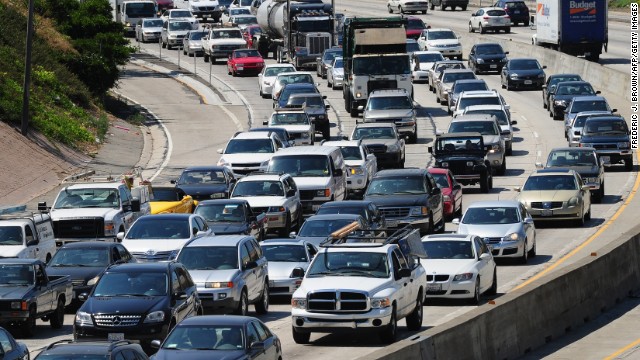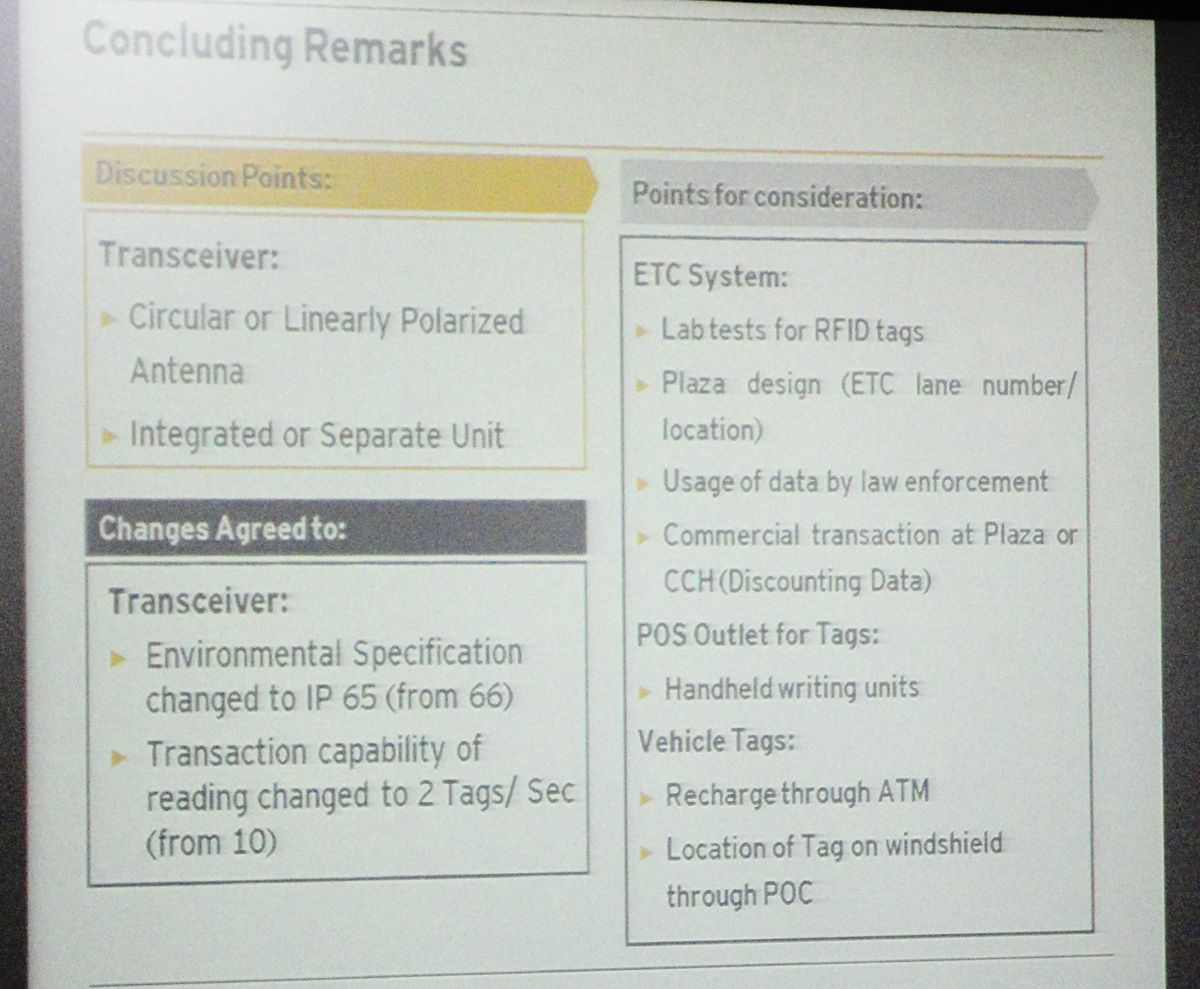Why you should stop talking to your car
June 17, 2013
By Clifford Nass, Special to CNN
(Commuters move slowly in Los Angeles. Studies show that talking to your car’s voice technology impairs driving.)
STORY HIGHLIGHTS
- Clifford Nass: More of our brain is devoted to speech than anything else; we love to talk
- Nass: Talking to technology in your car is not natural and it confuses your brain
- He says even with hands on wheel and eyes on road, talking to your car impairs driving
- Nass: Your brain works to fill in the blanks talking to an entity you can’t see and doesn’t listen
Editor’s note: Clifford Nass is the Thomas M. Storke Professor at Stanford University and director of the Communication between Humans and Interactive Media (CHIMe) Lab. He is the author of “The Man Who Lied to his Laptop: What Machines Teach Us About Human Relationships,” “Wired for Speech” and “The Media Equation.”(CNN) – Speaking is profoundly human: More of the human brain is devoted to speech than any other activity. People can have an IQ of 50, or a brain that is only one-third the normal size and have difficulties with many simple tasks, but they can speak.Humans are so tuned to words that from about the age of 18 months, children learn about eight to 10 new words a day, a rate that continues until adolescence.Humans love to speak: When two hearing people encounter each other, they will speak, despite having other means of communication such as gesturing or drawing. Even when people speak different languages or come from different cultures, they will try to find common words and phrases.One-day-old infants can distinguish speech from any other sounds and 4-day-olds can distinguish between their native language and other languages. Even in the womb, a fetus can distinguish her or his mother’s voice from all other female voices. Adults can distinguish speech sounds at twice the rate of any other sounds, aided by special hair cells in the outer right ear.

 Curbing distracted driving
Curbing distracted driving
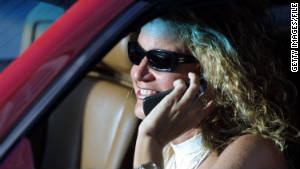 NTSB: No cell phones while driving
NTSB: No cell phones while driving
Among all animals, only humans have the necessary breathing apparatus and musculature to be able to speak: despite the “Planet of the Apes,” no primate could speak like a person, even if their brains grew. Even human ancestors such as the Neanderthal could not possibly speak: speech is a new and remarkably impressive ability.
So, there is nothing so human as speech — at least until modern technologies came along. Through striking advances in a computer’s ability to understand and produce speech, it is common to use your telephone to make airline reservations, answer questions and search the Web.
Because of the shrinking size and increasing speed of computers, it is also possible to speak directly to your automobile.
From putting up with the car intoning, “Your door is ajar,” we have moved to navigation systems that can tell you where to find a latte and car interfaces that understand spoken commands and even allow drivers to dictate e-mails, texts and make phone calls.
What could be more simple and natural than talking, even to a technology? And speaking to cars seems particularly desirable. We don’t have to take our eyes from the road or our hands from the wheel to select buttons or make choices: Why not let our mouths and our ears do all the work?
Unfortunately, it’s not so simple or so desirable.
Recent research by the AAA Foundation for Traffic Safety, conducted by David Strayer at the University of Utah, finds that the new technology can be so distracting it impairs the ability to drive. Studies found that while driving, our attention becomes overloaded by speaking. It basically takes our minds, if not our eyes, off the road.
Here are three reasons why talking while driving is so distracting, and not as safe and effective as you might think:
People like to picture who they are talking with. When you speak with someone face-to-face, you “hear lips and see voices”: Your brain automatically and easily focuses on the person.
When you speak on the telephone, you use brainpower to create a mental image of the person you are talking with: The less you know the person, the more mental workload it takes. When you talk to a car, use a phone in a car or dictate a text message, your brain has to do a great deal of work to picture with whom you are communicating. When you’re thinking that hard, it’s very difficult to pay attention to the road.
That’s why talking on a cell phone — hands free or not — is much more dangerous than talking to a passenger. The need to imagine steals from attention to the road.
People want to be understood. Although people love to speak, there are few more frustrating things than someone not listening. Listeners puts a great deal of energy into showing that they are listening: They nod their head, say “uh huh,” open their eyes and change their posture. People are built to expect these signals of attention, but cars refuse to provide them.
As a result, drivers become overly concerned with whether the car understands or is even listening, and their attention is again drawn away from the road. In addition, the voice of the car does not have the rich vocal cues that indicate engagement and emotion, providing further evidence that the car isn’t understanding.
Cars are not native speakers. When you encounter someone who isn’t facile in your language, you have to put a great deal of time into selecting the right words, avoiding idioms and speaking slowly and clearly. Speech is no longer an easy and natural means of communication in these instances.
While it is remarkable that cars can understand something that took billions of years of human evolution, the typical car recognition rate of 85% to 95% makes it a mediocre second-language speaker. As a result, speech becomes effortful and demanding, stealing attention from the road.
Because of these problems, my laboratory and laboratories around the world are trying to find ways to support the driver in creating mental images, in showing that the car wants to understand and enabling the car to understand at levels equal to or even better than a person.
And soon cars will be driving themselves, so that people can ignore the road and multitask their way to fighting for attention from each other, just as they do outside the car.
Source-http://edition.cnn.com
Workshop on Nationwide Electronic Toll Collection, held at Vigyan Bhawan, New Delhi on June 14, 2011
June 15, 2011
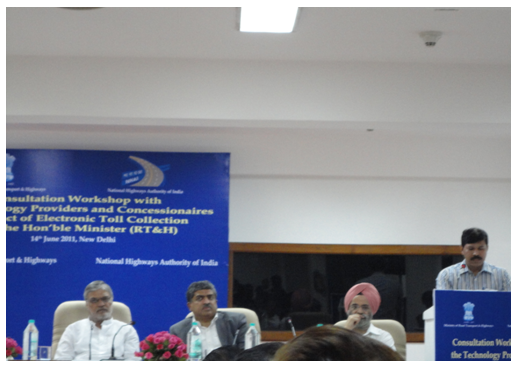
Workshop on Nationwide Electronic Toll Collection
- Mr. C P Joshi , Honrable Minister Road Transport and Highways
- Mr. Nandan Nilkani , Chairman , UIDAI
- Mr. R S GUJRAL , Chairman NHAI
- Mr. Ravi Palekar , GM (Electronics) , NHAI – Addressing the gathering
- Mr. Sachin Bhatia, CEO, Metro Infrasys
Workshop on Nationwide Electronic Toll Collection held at Vigyan Bhawan, New Delhi. With an objective of paving way for a unified Electronic Toll Collection (ETC) technology for National Highways in India, the Ministry of Road Transport & Highways constituted a Committee under the chairmanship of Shri Nandan Nilekani Chairman of UIDAI with a mandate to examine all technologies available for Electronic Toll Collection (ETC) and recommend the most suitable one for implementation throughout India. The other members of the Committee are Prof. Pankaj Jalote, Director, IIIT-Delhi ; Dr. Kolin Paul, Asst. Professor, IIT-Delhi ; Shri A.V. Sinha, DG (Road Development) & Special Secretary, MoRT&H and Shri. V.L. Patankar, Member (Technical), NHAI (Member Secretary).
The Union Minister for Road Transport & Highways Dr. C.P. Joshi has said that we should chalk out a plan to increase the percentage of national highways from present 2.2 % to 5 % in the next 10 years. Delivering inaugural address at the Consultation Workshop with the Technology Providers and Concessionaires in respect of Electronic Toll Collection (ETC) here today, he said that keeping in view the various types of highways there should be a hybrid pattern of toll collection. The Workshop was jointly organized by Ministry of Road Transport & Highways, National Highways Authority of India & National Informatics Centre. The Chairman of UIDAI Shri Nandan Nilkeni & Minister of State for RT&H Shri Tusharbhai A. Chaudhary also addressed the workshop. Shri R.S. Gujral, Secretary Ministry of Road Transport & Highways and Dr. V.K. Gairola, D.G (NIC) were present.
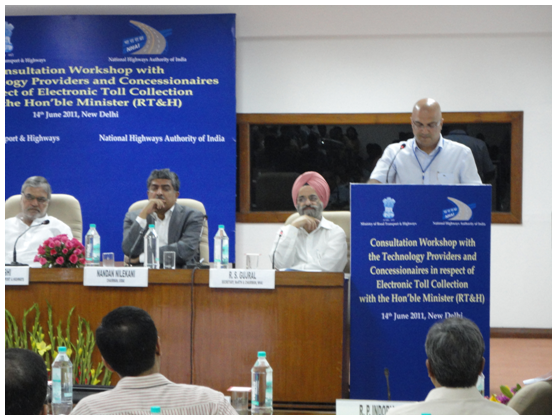
Mr. Sachin Bhatia CEO Metro Infrasys expressing the support from Industry Fraternity
Based on the recommendations of the committee headed by Mr. Nandan Nilekani to use RFID technology for ETC, the Apex Committee, responsible for ETC implementation planning, is in the process of prescribing certain standards which should be complied with all over the country to ensure interoperability. The primary purpose of this workshop was to take feedback from the key stakeholders, comprising concessionaires and ETC technology service providers. Security, cost effectiveness, convenience and scalability have been the main criteria based on which the detailing has been done.
Based on the feedback, the specifications and data detailing will be finalized for open market release. The plan is that the authorized manufacturers will be producing Transceivers and Tags based on these standards, the concessionaires will be procuring these Transceivers and in turn, the technology service providers will be integrating the entire ETC system at the toll plaza. Although details on other aspects like clearing house are being worked out simultaneously, majority of the decisions will depend upon these standards only.
Followings are the Tolling Companies, RFID Manufacturer and concessionaire took part in the workshop:
- Kapsch Metro
- Egis Infra
- L&T Infra
- GMR
- HCC Infrastructure
- JICA
- IRDSA
- DSC
- EFKON India
- Siemens
- IAITO Infotech Pvt. Ltd.
- ESSEN, Mumbai
- ATT System, Banglore
- Mitsubishi
- IBI Group
- Neology
- Steria
- Tag Factory
Brief of discussion over finalization of technology between committee and Industry Peoples:
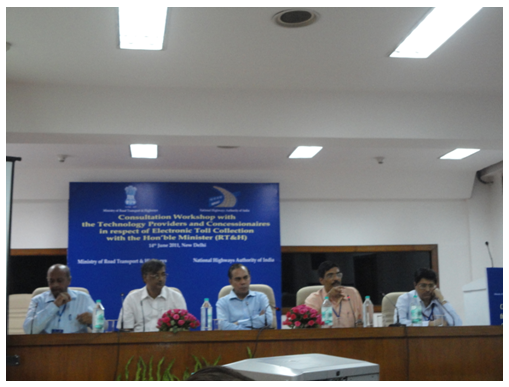
- Dr. B.K. Gairola, Director General, NIC – extreme left
- Dr. Y.K. Sharma, DDG, NIC - middle position
- Dr. Rajat Moona, Director General of CDAC, IIT Kanpur
- Dr. Y.K. Sharma, DDG, NIC - extreme Right
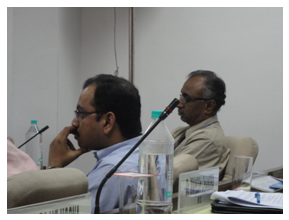 Mr. Venkat from GMR expressed change from IP 66 to IP 65 for the readers as IP 65 is also good enough and IP 66 will increase the cost for the readers without any additional value.
Mr. Venkat from GMR expressed change from IP 66 to IP 65 for the readers as IP 65 is also good enough and IP 66 will increase the cost for the readers without any additional value.
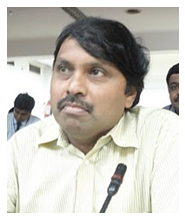 Mr. Hari from Efkon
Mr. Hari from Efkon
He raised an issue over the relative humidity of 100% for Transceiver antenna.
Committee Conclusion :
Committee agreed for the IP 65 standard and 95% relative humidity as it comply against all possible environmental threat at toll scenario.
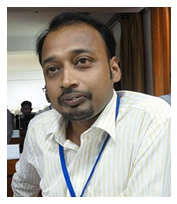 Mr. Anand Shenoy from IAITO Infotech Pvt. Ltd.
Mr. Anand Shenoy from IAITO Infotech Pvt. Ltd.
Raised his voice over minimum requirement of reading of 10 Tags per second with 240 bits of EPC memory and 64 bits of Tag Id.
Committee Conclusion: committee agreed onto change it to 2 Tags per second with above said minimum requirement. On the other query raised by Mr. Shenoy that the data retention period must be 3-4 year for the tag memory instead of 10 years as their is no UV protection asked for the tag and without any special material with the effect of UV rays its hard to maintain the data in tag for 10 years, The committee replied as they will keep it under consideration and if required they will bring it in next phase.
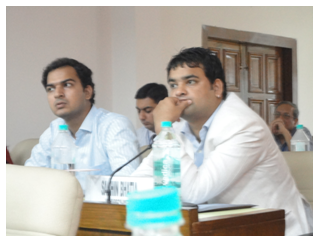 On the query raised by Team from Metro Infrasys- Mr. Nitin Thakur and Mr. Harimohan for the option of having color coded Tags for different class of vehicles, as it will help in operation at toll plazas. The Committee said that it is difficult to see the color in the moving car in the sun. However committee will discuss it in next phase.
On the query raised by Team from Metro Infrasys- Mr. Nitin Thakur and Mr. Harimohan for the option of having color coded Tags for different class of vehicles, as it will help in operation at toll plazas. The Committee said that it is difficult to see the color in the moving car in the sun. However committee will discuss it in next phase.
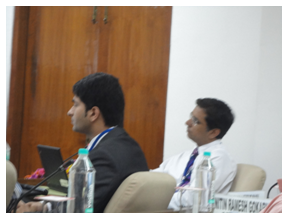 Mr. Vipul Sharma(Left), Mr. Mayank Manish(Right)
Mr. Vipul Sharma(Left), Mr. Mayank Manish(Right)
The long discussed topic was the polarization standard for the antenna, Panel has asked for circular polarization pattern for the antenna but Mr. Vipul Sharma and Mayank Manish from one of the leading manufacturer of RFID Equipment Neology reasoned to have it linearly polarized due to its long range and less interference phenomenon, also linearly polarized antennas can work at higher speed , committee keep this for discussion and will revert again.
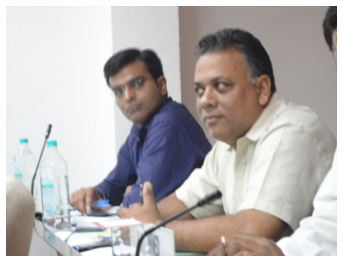 Mr. Manoj Agarwal and Mr. Manish from Delhi Gurgaon Expressway strongly supported the idea of a law for putting a penalty on cash vehicles coming to Tag lane .
Mr. Manoj Agarwal and Mr. Manish from Delhi Gurgaon Expressway strongly supported the idea of a law for putting a penalty on cash vehicles coming to Tag lane .
For the standard for the communication between plaza server and CCH server, there will be addition of Plaza id into the prescribed format by the committee. Plaza level fare plan and policy will be governed by the plaza itself while the global discount will be governed by the CCH server and will be updated in all the plaza server by CCH server itself. Committee also agreed to look into the various aspects of fare plans at different plazas.
Highlights of the Workshop:
ETC critical components:
Tag Distribution Channel & Inventory Management
- On-line channels by user
- Authorized service centers of vehicles (Service centre need to install the SPV client software and antenna connection), since centre must have authorized people to affix tags.
- RTO(Operation is similar to above)
- Vehicle dealer network(Operation is similar to above)
- Authorized point of sale installation(POS can be insurance companies, PUC centers, Petrol Pumps etc; Operation is similar to above)
Inventory Management of Tags:
SPV will keep track of allocated EPC Ids, Tag Ids etc. It will perform a demand forecast Tags and keep the tags available for distribution through distribution channel.
Handling Special Cases
- Valid ETC enabled vehicle was ejected due to non-read of Tag – Premium cash lane should verify it with the ETC database.
- Clone Tag – If customer complains/suspects that his/her Tag is cloned, Tag re-initiation is to be done for same Tag. Old Tag value is marked for special handling.
- Change in registration number of vehicle – Vehicle should approach distribution channel network and get a new tag. Old tag is to be destroyed physically and listed for special handling.
- De-registration of vehicle (due to destruction/ end of life/ Export etc.)-Tag is to be destroyed physically and listed for special handling.
Listing for Special Attention
Vehicle is listed for special attention following conditions:
- Insufficient balance as determined by clearing house
- Credit card co. declined the payment
- On Police look-out
- Suspected cloned Tag
- Tag with invalid Vehicle Registration no. (e.g. when Registration no. is changed)
- When toll plaza operator notices Tag carrying details different from vehicle itself (e.g. the vehicle Registration no. and/ or Vehicle class)
Videos
Conclusions drawn at the end of the seminar:
Documents Attached:
- Agenda Workshop
- Apex Committee for ETC Implementations – GOI, Draft Specifications Document
- ETC Report on RFID – July 2010
 This story is covered by Mr. Sachin Bhatia.
This story is covered by Mr. Sachin Bhatia.
Human Error Is 3rd Largest Cause For Accidents
June 13, 2011
Overspeeding, drunken driving and lack of lane discipline are the key reasons for accidents on national highways, say police as well as highways department officials.
While going into detailed reasons like absence of blinkering lights on medians and zig zag roads that are possible reasons for accidents on the National Highways, a study by the police department in five national highways says that these design defects could be nullified if human error is eliminated.
”To start with we have started cracking down on drunken driving on the Tiruchi-Perambalur National Highway 45 where frequent accidents were reported. The efforts have started showing results,” said Tiruchi range DIG A G Mourya who commissioned the study.
The study on NH 45 (Tiruchi-Perambalur), NH 45B (Tiruchi-Madurai), NH 210 (Tiruchi-Pudukottai), NH 45A (Anaikarai bridge in Ariyalur to Pappakudi), has revealed that the number of fatal accidents in these sections have increased in 2010 than the previous year and there is little indication of the accidents declining in 2011. Only in two stretches—NH 67 (Tiruchi-Karur) and NH 7 (Aravakurichi-Thavuttupalayam)—have come down. Incidentally these stretches are yet to be four laned.
